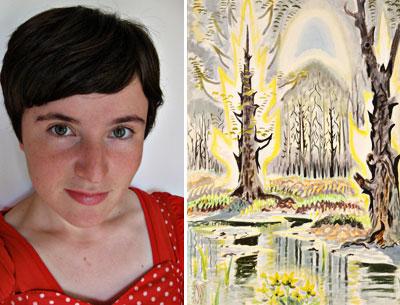‘Watercolors’: Painting With Sound

The opening of the Parrish Art Museum’s new building in Water Mill on Saturday will include a multimedia concert of compositions by a young composer with local roots.
Both Sag Harbor and San Francisco were home in Nell Shaw Cohen’s bicoastal upbringing. Soon after her parents moved to Sag Harbor full time, the budding composer was off to the New England Conservatory of Music in Boston. Now 24 and pursuing graduate studies in composition at New York University, Ms. Cohen will present “Watercolors,” a 15-minute piece inspired by four paintings by the watercolorist Charles Burchfield, at the Parrish opening. One of the four, “Glory of Spring,” is in the museum’s permanent collection.
The Chelsea Quintet will perform “Watercolors” in front of projected images of the paintings in the new museum’s performance space.
The intersection of aural and visual is familiar territory for Ms. Cohen. Much of her work is inspired by visual art, including a 2011 collaboration with the Peabody Essex Museum in Salem, Mass., and members of the string orchestra A Far Cry, to present music inspired by the work of the 19th-century painter Thomas Cole.
“The first piece I composed inspired by art was ‘The Course of Empire,’ ” Ms. Cohen said of her 2008 piece, a string quartet inspired by Cole’s paintings.
Visual art has always been significant in her life, she said. As a teenager she was particularly fascinated by art history. “As I got deeper into composing, I realized that I could bring these two passions together. I sought to communicate my interpretation of the art, so that when listeners are hearing the music, it’s music that stands alone, but it also has this connection to something larger. It’s almost like an essay in the musical form, but not that literal. Once I started doing that, I realized that it was a way for me to continue engaging in the visual art that I found compelling, and share that with people in my own way, which is through music.”
Another fascination, she said, is synesthesia, “an anomalous blending of the senses in which the stimulation of one modality simultaneously produces sensation in a different modality,” according to Thomas J. Palmeri, Randolph B. Blake, and René Marois, who study the phenomenon at the Center for Integrative and Cognitive Neuroscience at Vanderbilt University. A synesthete “hears” colors, for example.
This explains Ms. Cohen’s obsession — her word — with Burchfield. “His art is really fascinating,” she said. “It’s especially suggestive of music. Some feel he was a synesthete in that he experienced a psychological connection between music and art. Some of his art — the colors, the shapes, the whole way he conceptualized it — has a very musical quality. And some of his paintings literally depict sounds, where he has jagged lines or repeating circular lines that represent insect noises and birdcalls. He said that he was thinking about Beethoven and Sibelius while he was making his paintings.”
As to her own approach to composing art-inspired music, “I try to have a really good sense of what my take on the painting is before I start writing notes, because I really want the music to be a natural extension of my experience of the painting,” she said. “I interpret the paintings into music on several levels. There’s a larger narrative or atmospheric quality that I might get — that’s almost a film score-type approach — where I’m thinking, what is the musical atmosphere that can support and embody this visual? Then there are more specific things. If there are jagged shapes or lines in the visuals, I might write music that has an angular, jagged quality, or if it’s flowing and lyrical, I might create something of the musical equivalent.”
Colors, and light and dark, are also manifested in her music. “Sun and Rocks,” the third of four movements in “Watercolors,” “has these very vibrant, striking colors, and the whole picture almost seems to be vibrating,” Ms. Cohen said. “So I created music that had extremes of dynamics — loud and quiet — and extremes in register — really high notes and really low notes — to capture that intensity that I saw in the painting.”
The process is, of course, subjective and personal: different composers may interpret a painting in dramatically different ways, but “it’s a direct response to what I’m seeing in the painting,” she said.
Ms. Cohen’s Web site, beyondthenotes.org, includes recordings of “Watercolors” and video interviews with experts on Burchfield and synesthesia, as well as her own videotaped discussions of the creative process, among other features. The site also features a blog in which Ms. Cohen writes about “Watercolors” and her other work.
“Watercolors” will be presented at 12:30 p.m. and again at 2:30 p.m. on Saturday. Admission to the museum and concert is free.
